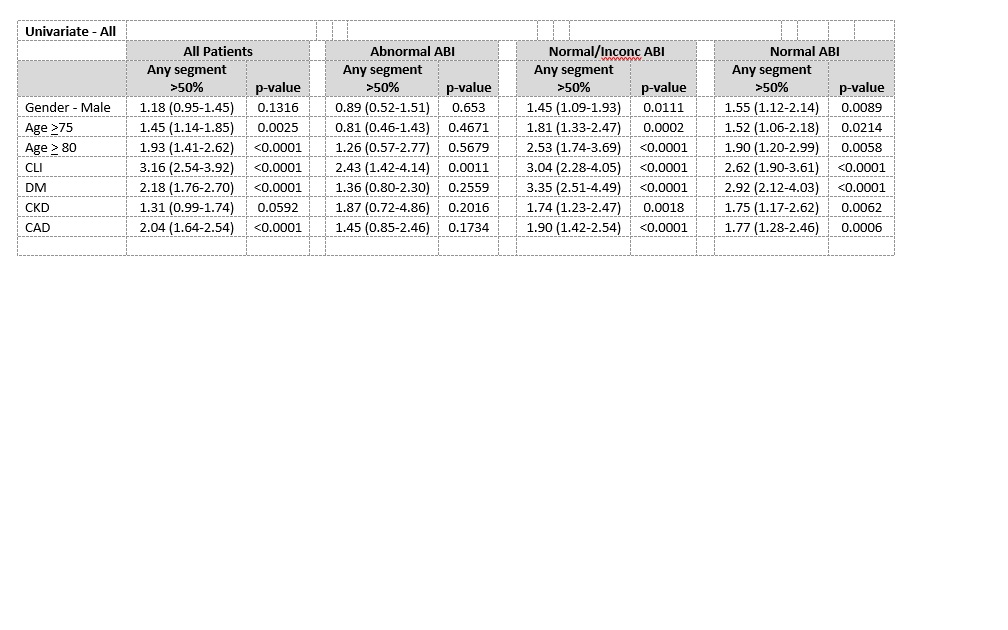Critical Analysis and Limitations of Resting Ankle-Brachial Index in the Diagnosis of Symptomatic Peripheral Arterial Disease: Role of Diabetes Mellitus and Chronic Kidney Disease
Elliot Adams, MD1, Ali F. AbuRahma, MD1, Joseph AbuRahma, MD1, Luis Mata, MD1, Cristyn Caron, BS, RVT, RDMS2, Jennifer Sloan, BS, RVT, RDMS2, L. Scott Dean, PhD, MBA3, Mary Emmett, PhD3.
1Robert C. Byrd HSC, West Virginia University, Charleston, WV, USA, 2Charleston Area Medical Center, Charleston, WV, USA, 3CAMC Health Education and Research Institute, Charleston, WV, USA.
Background: ABI may underestimate the severity of PAD in patients with non-compressible vessels. This study analyzed limitations of resting ABI and TBI, in patients with symptomatic PAD, diagnosed by duplex ultrasound (DUS), particularly diabetics (DM) and chronic kidney disease (CKD).
Methods: Prospectively collected data on patients tested for PAD of the lower extremity were analyzed. All patients underwent resting ABI, TBI, and/or DUS. An ABI of ≤0.90 in either leg was considered abnormal, and the term “inconclusive ABI” (non-compressibility) was used if the ABI was ≥1.3. A TBI of <0.7 was considered abnormal.
Results: This study included 2226 ABIs and 1383 DUS: 46% of patients had DM, 16% had CKD. 1178 (53%) ABIs were normal, 754 (34%) were abnormal, and 294 (13%) were inconclusive. For critical limb ischemia: 40% had normal ABI, 40% abnormal ABI, and 20% were inconclusive.
The sensitivity, specificity, overall accuracy (OA), positive predictive value (PPV), and negative predictive value (NPV) for ABI in detecting ≥50% stenosis in the whole series were: 58%, 91%, 74%, 86%, and 69%; for diabetics 51%, 89%, 66%, 88%, and 55%; non-diabetics 66%, 92%, 81%, 84%, and 80% (p<0.0001). For CKD patients: 43%, 95%, 67%, 91%, and 58% versus no CKD 60%, 90%, 76%, 85%, and 71% (p<0.0001). If patients with inconclusive ABIs were excluded, these values were 67%, 86%, 75%, 88%, and 64% for diabetics; 63%, 94%, 78%, 91%, and 71% for CKD patients (p<0.0001).
297 limbs had both TBI and DUS. The sensitivity, specificity, OA, PPV, and NPV for abnormal TBI in detecting ≥50% stenosis were 85%, 62%, 75%, 76%, and 75% in the whole series; 84%, 58%, 74%, 76%, and 70% for diabetics; and 77%, 64%, 72%, 79%, and 62% for CKD.
Regression analysis showed patients with normal/inconclusive ABIs had 3.35 likelihood of ≥50 stenosis for diabetics versus non-diabetics (p<0.0001); and 1.74 for CKD versus none (p=0.0018, Table).
Conclusions: 43% of symptomatic PAD patients with ≥50% stenosis on DUS had normal/inconclusive resting ABIs, 49% in diabetics, 57% in CKD patients. TBI may help in patients with inconclusive ABIs. This suggests these patients should undergo further imaging for proper treatment. 
Back to 2019 Abstracts
